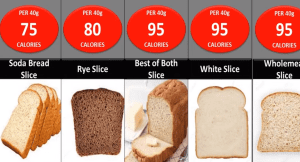Oatnut Bread Nutrition
Oatnut Bread Nutrition: A Delicious and Nutritious Choice for Your Diet
If you’re searching for a nutritious and tasty bread option, look no further than oatnut bread. Oatnut bread is a delicious combination of oats and nuts, providing a unique flavor and texture that is hard to resist. But what exactly is oatnut bread nutrition like? Let’s dive in and explore the health benefits and nutritional content of this wholesome bread.

The Power of Oats and Nuts
Oatnut bread combines the goodness of oats and nuts, making it a nutritious choice for bread lovers. Both oats and nuts are packed with essential nutrients that can offer numerous health benefits. Oats are an excellent source of dietary fiber, which helps to regulate digestion, control blood sugar levels, and support heart health. Nuts, on the other hand, are rich in healthy fats, protein, and various vitamins and minerals. They are known for their ability to promote heart health, help with weight management, and provide a good dose of antioxidants.
Nutritional Content of Oatnut Bread
Oatnut bread nutrition varies slightly depending on the specific ingredients used by different brands or recipes. However, a typical serving of oatnut bread contains the following nutritional content:
1. Calories and Macronutrients
– Calories: On average, a two-slice serving of oatnut bread contains around 220 calories.
– Carbohydrates: Oatnut bread is a good source of complex carbohydrates, providing around 40 grams per serving.
– Protein: You can expect about 8 grams of protein in a two-slice serving.
– Fat: Oatnut bread is relatively low in fat, with approximately 4 grams per serving.
2. Fiber and Whole Grains
– Fiber: Oatnut bread is rich in dietary fiber, with around 5 grams per serving. This high fiber content can help support digestive health and keep you feeling fuller for longer.
– Whole Grains: Oatnut bread is typically made with whole grain oats, which are naturally rich in vitamins, minerals, and antioxidants. The presence of whole grains in oatnut bread contributes to its overall nutritional value.
3. Vitamins and Minerals
– Oatnut bread can be a good source of essential vitamins and minerals, including:
– B vitamins: Oats and nuts contain various B vitamins, such as thiamine, niacin, and folate, which are involved in energy production and overall cellular function.
– Vitamin E: Nuts are known for their vitamin E content, an antioxidant-rich vitamin that helps protect cells from damage.
– Iron: Oatnut bread can provide a small amount of iron, a mineral important for oxygen transportation in the body.
– Magnesium: Both oats and nuts are rich in magnesium, a mineral needed for bone health, muscle function, and overall wellbeing.
Health Benefits of Oatnut Bread
With its nutritious ingredients, oatnut bread comes with several health benefits. Let’s take a closer look at some of the advantages of incorporating oatnut bread into your diet:
1. Heart Health
– The combination of oats and nuts in oatnut bread can positively impact heart health. Both oats and nuts have been linked to lower cholesterol levels and improved overall cardiovascular health. The high fiber content of oats can help reduce LDL (bad) cholesterol, while the healthy fats in nuts can promote healthy cholesterol levels and reduce the risk of heart disease.
2. Weight Management
– Oatnut bread’s high fiber and protein content can make it a satisfying addition to a weight management plan. The fiber helps you feel fuller for longer, reducing the likelihood of overeating, while the protein can support muscle growth and maintenance.
3. Blood Sugar Control
– The slow release of carbohydrates from oats in oatnut bread can help stabilize blood sugar levels. This gradual release prevents spikes and crashes in blood glucose, making oatnut bread a great choice for those with diabetes or those looking to manage their blood sugar levels.
4. Digestive Health
– Oatnut bread’s fiber content promotes good digestive health by supporting regular bowel movements and preventing constipation. The soluble fiber found in oats also acts as a prebiotic, nourishing the beneficial bacteria in your gut and promoting a healthy digestive system.
Frequently Asked Questions
1. Is oatnut bread gluten-free?
– No, oatnut bread is not gluten-free. Traditional oatnut bread recipes contain wheat flour, which contains gluten. However, gluten-free versions of oatnut bread can be found or made using gluten-free flour alternatives.
2. Can oatnut bread be included in a low-carb diet?
– Oatnut bread is not typically recommended for a strict low-carbohydrate diet, as it contains a moderate amount of carbohydrates. However, if you are following a flexible or moderate carbohydrate plan, oatnut bread can still be enjoyed in moderation.
3. Is oatnut bread suitable for vegans?
– Oatnut bread can be vegan-friendly depending on the specific recipe and ingredients used. Some recipes may include animal-based products such as milk or eggs, so it’s important to check the ingredient list or opt for vegan versions.
Final Thoughts
Oatnut bread nutrition makes it a fantastic option for those seeking a wholesome and delicious bread choice. Its combination of oats and nuts brings together a variety of essential nutrients and health benefits. Whether you’re looking to improve heart health, manage weight, regulate blood sugar, or support digestion, oatnut bread can play a beneficial role in your diet. So next time you’re at the grocery store, consider grabbing a loaf of oatnut bread and enjoy the nutritional goodness it has to offer.







